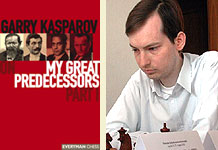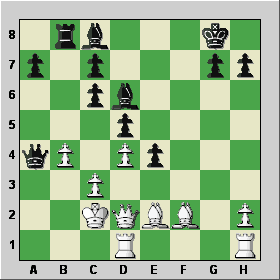Analysis Focus #1: Garry Kasparov's Great Predecessors
|
Analysis Focus #1

GM Karsten Müller on Bird–Morphy, London, 1858 (p.
37)
|
|
The release of Part One of Garry Kasparov's "My Great Predecessors" series
has caused major ripples throughout the chess world. It seems no player, writer,
or fan is without an opinion. Every sentence, every variation is being scrutinized
– and all with encouragement from a surprising source: the author.
Since the books initial release in Russian, Kasparov has spoken of this series
as almost a challenge to the chess world to find improvements and turn the books
into a definitive museum of classical chess. One thing that has been overlooked,
is that Kasparov has experience with the power of global mass-mind analysis.
In his amazing "Kasparov against The World" on the Internet in 1999, Kasparov
played the most heavily analyzed game of all time. Literally thousands of lines
were produced after each move, by thousands of players and their computers around
the world, month after month. The result was an opponent that came very close
to holding a draw in what has been called by many authors one of the greatest
games of all time.
There is always more analysis to be done; it never ends and no evaluation is
final. But with many eyeballs looking, you can come much closer to seeing the
truth. This article is the first part of what will be an ongoing series of analysis
related to contents of Garry Kasparov's "Predecessors" books. With the
participation of publisher Everyman, Garry Kasparov himself, our analysts (human
and silicon), and of course you, the reader, we will dig deeply into every game.
|
Garry Kasparov is encouraging the readers of his book
to take up the analysis with him. "One of the tasks of this book is to
inspire creative discussion. Because undoubtedly there will be many questions
asked while reading the book. Today we have the luxury of all amateurs
being able to understand the complexity of the game, by analysing with
the computer. It is no longer a secret that belongs to top players and
some experts. Everyone can search for chess truth and ask questions.

Click on the picture to view the video clip
The above video clip is part of a 90-minute
chat session Garry Kasparov gave from New York on the Playchess.com
server server in July this year. You will need a Microsoft
Media Player 9 to replay it.
|
German Grandmaster Karsten Müller starts things off. He has performed
and compiled an incredible amount of analysis on the famous game Bird-Morphy,
London, 1858, and here includes Garry Kasparov's new contributions.
Dr. Karsten Müller was born November 23, 1970 in Hamburg, Germany. He earned
the Grandmaster title in 1998, a PhD in mathematics in 2002 at the University
of Hamburg. With IM Frank Lamprecht he is the co-author of "Secrets of Pawn
Endings" (Everyman 2000) and "Fundamental Chess Endings" (GAMBIT 2001), and
with FM Claus Dieter Meyer of "Magic of Chess Tactics" (Russell Enterprises
2003). His column "Endgame Corner" has appeared at www.ChessCafe.com since January
2001 and he has been a regular contributor to ChessBase Magazine since 1997.
The Riddle of Bird vs Morphy
Garry Kasparov's excellent new work on his great predessors contains so much
analysis of the battles for the highest crown of chess that it is a real pleasure
to study and devour. With so many old well investigated positions and deep problems
it is no wonder that there are still questions open, one of them is the following
old riddle:
Bird,H - Morphy,P [C41]
London casual Bird London, 1858
[Mueller,Karsten]
1.e4 e5 2.Nf3 d6 3.d4 f5 4.Nc3 fxe4 5.Nxe4 d5 6.Ng3 e4 7.Ne5 Nf6 8.Bg5
Bd6 9.Nh5 0-0 10.Qd2 Qe8 11.g4 Nxg4 12.Nxg4 Qxh5 13.Ne5 Nc6 14.Be2 Qh3 15.Nxc6
bxc6 16.Be3 Rb8 17.0-0-0.

In this position the American chess genius played 17...Rxf2! 18.Bxf2
Qa3!! An amazing move from one edge of the board to another 19.c3!
Qxa2 20.b4 Qa1+ 21.Kc2 Qa4+

22.Kb2? A bad mistake, Bird cracks under the pressure. The
game ended 22...Bxb4! 23.cxb4 Rxb4+ 24.Qxb4 Qxb4+ 25.Kc2 e3 26.Bxe3
Bf5+ 27.Rd3 Qc4+ 28.Kd2 Qa2+ 29.Kd1 Qb1+ 0-1.
The critical defence in the above position is 22.Kc1! Many sources claim that
it is sufficient for a draw, while some believe in Morphy's attack.
-
Euwe and Nunn write in The Development of Chess Style
(p. 38, Batsford 1997): "22.Kc1! Qa1+ leads to perpetual check. This is
the best line, but it means that with his pretty combination Black has thrown
away the win."
-
Neistadt in Uncrowned Champions: "After 22.Kc1
Morphy would have had nothing better than satisfying himself with perpetual
check."
-
Fred Reinfeld and Andrew Soltis in their book Morphy
Chess Masterpieces (First Collier Books Edition 1974, in descriptive
notation, which has been converted to algebraic): "Legend has it that when
an onlooker found that 22 Kc1! draws, no one would speak to him for a week.
The point of 22 Kc1! is that 22...Bxb4? 23 cxb4 Rxb4 is not check so that
White might escape with 24 Qg5! Qa3+ 25 Kd2 Rb2+ 26 Ke1 Rxe2+ 27 Kxe2 Qf3+
28 Ke1 Qxh1+ 29 Qg1! and wins. So Black would have to take a perpetual check
with 22...Qa1+."
-
Anatoly Karpov has produced a deep investigation of the
fascinating endgame after 22...a5 23.Qc2 Qa3+ 24.Qb2 axb4 25.Qxa3 bxa3 and
revealed many hidden White resources. His main line runs 26.Be3 a2 27.Kc2
Ba3 28.Ra1 Rb2+ 29.Kd1 Bd7 30.Rf1 c5 31.dxc5 Ba4+ 32.Ke1 Bb3 33.Bd4! Rb1+
34.Kd2 Rxa1 35.Rxa1 Bb2 36.Rg1 g6 37.h4 a1Q 38.Rxa1 Bxa1 39.Kc1 Ba2 and
he concludes "Both sides are guaranteed a draw, Black is two pawns up, but
his bishops are in seclusion." This is to be found in his work Miniatures
from the World Champions (Collier Books 1985). The Soviet masters Gik
and Rozenberg contributed to the analysis.
- Garry Kasparov calls the previous try unclear and prefers
22.Kc1 Bf5! 23.Be1! Qa1+ 24.Kc2 e3+ 25.Kb3 exd2 26.Rxa1 Re8 27.Ba6 dxe1Q 28.Raxe1
Rxe1 29.Rxe1 Bxh2 30.Bb7 Be4 31.Bxc6 Kf7, which leaves Black with a small
advantage.
So was Morphy's original rook sacrifice 17...Rxf2! sound?
Kasparov writes: "I raise my hat to the great chess artist, but the crude 17...Bg4!
was correct, or even, according to Euwe, the slow 17...Bf5 and ...Bg6". (see
p. 38 of My Great Predecessors I).
In my at Chess Cafe Endgame Corner column No. 23, November 2002 (available
as a PDF file) I came
to the conclusion that Morphy's brilliant sacrifice was correct. At least I
did not, at the time, manage to find a drawing line for White.
So what is the correct assessment of Morphy's rook sacrifice? Did he have a
forced win after 17...Rxf2!, or was it necessary for him to
play Kasparov's mundane 17...Bg4 or Euwe's quite 17...Bf5 to win the game against
perfect defence. Send us your opinion and analysis on this historical position.
The contact form is given at the bottom of this page.



























